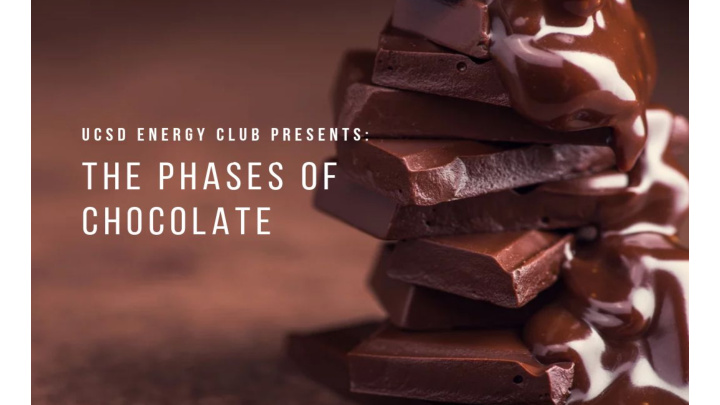



Chocolate’s journey 600AD Mayans, ➔ Aztec, Incas Xocolatl ➔ Cocoa ➔ drink made of crushed beans, spices and water
Chocolate’s journey 1520 - 1660 Brought to ➔ Spain, Italy, France Added sugar, ➔ but still bitter Drink for the ➔ wealthy
Chocolate’s journey Early 1700’s Brought to England ➔ Milk added to the ➔ drink Chocolate houses ➔
Chocolate’s journey 1828 Van Houtens ➔ developed Dutching process to better disperse cocoa in hot water and reduce bitter flavor
Chocolate’s journey 1847 First chocolate bar ➔ produced in England Joseph Fry ➔
Components of chocolate Sugar Cocoa nibs Cocoa pod Cocoa bean Cocoa Milk Genetic varieties: Criollo, Forastero, Trinitario, Nacional
From bean to bar process Cleaning Fermenting & Drying Winnowing Roasting Grinding & Conching Beans separated from pods and ➔ left to ferment at 120C for ~5 days Tempering
From bean to bar process Cleaning Fermenting & Drying Winnowing Roasting Grinding & Conching Beans are dried to bring down ➔ moisture content Tempering
From bean to bar process Cleaning Fermenting & Drying Winnowing Roasting Grinding & Conching Beans are ground to remove shell, ➔ leaving just the nibs Tempering
From bean to bar process Cleaning Fermenting & Drying Winnowing Roasting Grinding & Conching Nibs are roasted to kill micro-bacteria ➔ and remove acidic and bitter flavors Tempering
From bean to bar process Cleaning Fermenting & Drying Winnowing Roasting Grinding & Conching Chocolate liquor is ground to reduce ➔ particle size to ~30um. Cocoa butter and sugar are added Tempering ➔
From bean to bar process Cleaning Fermenting & Drying Fat blooms Winnowing Roasting Tempering Grinding & Conching Process of heating and cooling ➔ chocolate to achieve the right crystal Tempering structure for glossy, snappy chocolate
Cocoa motion - The role of viscosity Viscosity: Internal friction to motion Applying shear force to a liquid Ideal cocoa particle size is 30 um ➔ Fat aids in chocolate flow ➔ ➔ Emulsifiers help smoothen interface between fat and solids Viscosity of cocoa liquor ground to different finenesses showing non-newtonian behavior
Cocoa motion - The role of viscosity Viscosity: Internal friction to motion Applying shear force to a liquid Ideal cocoa particle size is 30 um ➔ Fat aids in chocolate flow ➔ ➔ Emulsifiers help smoothen interface between fat and solids Viscosity of cocoa liquor ground to different finenesses showing non-newtonian behavior
Fat crystallization Triglyceride structure ➔ Cocoa butter has six different phases Type V is ideal for its glossy ➔ appearance, snap and resistance to fat blooms Different crystal structure packing arrangements ➔ Higher fat content leads to lower melting temperature
Chocolate Tasting Competition 1. There will be 7 different chocolates on the table 2. Try to match each chocolate with the correct origin/composition 3. Write down your answers on the sheet 4. The person with the highest number of correct answers wins a prize!
Nibble: Dominican Republic Grown in Finca Elvesia, Genetic variety: Dominican Republic Trinitario Tropical ➔ Regular rains ➔ Cold nights ➔ Manufacturing: Nibs are stone-ground and mixed with sugar Flavor profile: A rich and bold chocolate with balanced earthy ★ flavors and coffee notes. Cherry, ripe mango and banana with bright acidity ★
Nibble: Madagascar Grown in Sambirano Valley, Madagascar Genetic variety: Mountain ranges and trade winds Trinitario ➔ assist rain in flooding the nearby rivers, depositing extremely fertile alluvia Leads to the growth of sweeter ➔ and less bitter cocoa Manufacturing: Nibs are stone-ground and mixed with sugar Flavor profile: A bright and exciting chocolate with citrus, raspberry and plum notes, ★ underlying earthiness and a zesty finish
Nibble: Peru Grown in Tumbes, Peru Genetic variety: Coastal climate Criollo ➔ Manufacturing: Nibs are stone-ground and mixed with sugar Flavor profile: A delightful complex chocolate with caramel and dry fruit ★ raisin notes, underlying maltiness and a long lasting finish.
Nibble: Brazil Grown in Bahia, Brazil Genetic variety: Cultivation is integrated into Trinitario ➔ the native forests (as opposed to crops) which generates a unique texture, and flavor Manufacturing: Nibs are stone-ground and mixed with sugar Flavor profile: A stimulating and balanced chocolate with floral and tropical fruit ★ notes, hints of lemongrass and pineapple, great acidity and a long lasting finish with macadamia undertones.
Nibble: Brazil, extra dark Genetic variety: Grown in Bahia, Brazil Trinitario Cultivation is integrated into ➔ the native forests (as opposed to crops) which generates a unique texture, and flavor Manufacturing: Nibs are stone-ground and mixed with sugar Flavor profile: A stimulating and balanced chocolate with floral and tropical fruit ★ notes, hints of lemongrass and pineapple, great acidity and a long lasting finish with macadamia undertones.
Green & Black’s: Dark 70%, Organic Blend of beans from Genetic variety: different regions Trinitario Manufacturing: Conventional method (as shown before) Flavor profile: Complex fruit notes and intense bittersweet ★ chocolate aromas Blend leads to more balanced flavors ★ Vanilla added to enhance chocolate aromas ★
Hershey’s: Special Dark Blend of beans from Genetic variety: different regions Forastero Manufacturing: Conventional method (as shown before) Flavor profile: Made from Forastero beans, which ★ are often considered to be of lower quality than Trinitario and Criollo
Chocolate Tasting Competition 1. There will be 7 different chocolates on the table 2. Try to match each chocolate with the correct origin/composition 3. Write down your answers on the sheet 4. The person with the highest number of correct answers wins a prize!
References 1. The Science of Chocolate, Stephen Beckett, 2008 2. Bean to Bar Chocolate, Megan Giller, 2017 3. Jennifer and Sandra at Nibble Chocolate - 2754 Calhoun St, San Diego
Correct Matching Sequence A → Peru B → Hershey’s C → Brazil, extra dark D → Dominican Republic E → Madagascar F → Green & Black’s G → Brazil Bonus Question → White 1 Milk 2 Dark 3
Recommend
More recommend